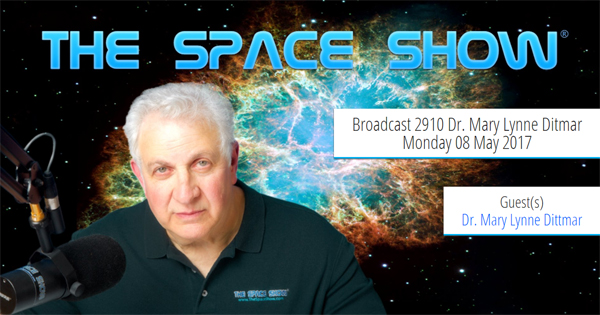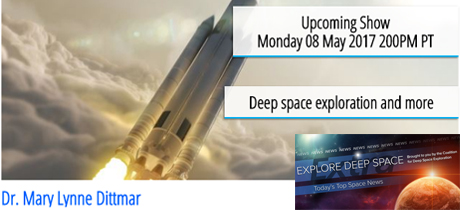In Today’s Deep Space Extra… A 2017 budget measure signed by President Trump on Friday provides NASA with $19.653 billion.
Got questions about human deep space exploration or space science? Join Mary Lynne Dittmar this evening on The Space Show LIVE from 5-6:30 p.m. ET. Call in with questions to 866-687-7223. Click here to learn more.

Human Deep Space Exploration
Trump signs $1 trillion spending bill, keeps government open
Associated Press via New York Times (5/5): President Trump signed a 2017 appropriations measure Friday that funds government operations through September 30, the end of the current fiscal year. The measure, which was approved by the House and Senate earlier in the week, includes $19.653 billion for NASA, a $368 million increase over 2016 and $628 million more than proposed for 2017 by President Obama.
NASA Langley runs more wind tunnel tests on Space Launch System rocket models
Hampton Roads Daily Press of Virginia (5/7): In a modest NASA Langley Research Center wind tunnel, engineers have subjected a scale model of the Space Launch System rocket to various launch pad wind conditions like those expected at the exploration rocket’s Kennedy Space Center launch complex in Florida. The first launch of the SLS and Orion crew capsule from Florida is to send Orion around the moon and back to Earth for an ocean splashdown and recovery. Future launches are to start human explorers on missions of deep space exploration.
Space Science
Mars may not have been born alongside the other rocky planets
Space News (5/5): Mars may have formed deeper into the solar system than thought, perhaps where the asteroid belt is now, according to new modeling that seeks to explain differences in the chemistry of the Earth and Mars. Migrations of Jupiter and Saturn may have played a role in shaping the inner solar system. The findings, led by a University of Colorado researcher, are to be published in the journal Earth and Planetary Science Letters.
Only 10 light-years away, there’s a baby version of the solar system
Universe Today (5/6): Ten and a half light years away, the planetary system Epsilon Eridani, with its dual asteroid belts and large debris disk, may resemble what the solar system looked like long ago, according to a new study published in the Astronomical Journal.
TRAPPIST-1 planets have no large moons, study argues
Seeker.com (5/5): Trappist-1, a recently discovered and tightly packet planetary system with rocky planets in the habitable zone of its star, appears moonless, according to a new study led by San Francisco State University astronomer Stephen Kane. As on Earth, moons may add a gravitational influence important for biological activity.
Paging Star-Lord! Hubble spies hundreds of galaxies that need guarding
Space.com (5/5): The Hubble Space Telescope’s latest “deep field” observing campaign turned to gravitational lensing to gather imagery of some of the most distant galaxies in the universe. The project relied, in part, on the mass of Abdell 370, a galaxy cluster four billion light years away, to expose the more distant, older star systems.
Ancient meteor strike triggered eruptions lasting up to a million years
Space.com (5/6): Ancient impacts from meteors and comets may have had a greater impact on the Earth’s evolution than believed previously, according to findings from an Irish-led research effort. One focus of the effort was the Sudbury basin of Canada, which may have been caused by an impact with a comet more than nine miles wide. The blows may have triggered volcanic activities that were long lasting.
Low Earth Orbit
X-37B spaceplane returns to Earth and makes autopilot landing in Florida
Spaceflightnow.com (5/7): A U.S. Air Force X-37B automated reusable spaceplane touched down at NASA’s Kennedy Space Center on Sunday at 8 a.m., EDT, ending a classified 718 day flight. The flight of the unmanned winged spacecraft was the fourth for the program. The landing on the former Shuttle Landing Facility runway at Kennedy was a first for the venture.
South Asia Satellite puts Indian diplomacy in new orbit
Deccan Herald of India (5/5): Launched Friday, India’s South Asia Satellite, is intended to benefit seven regional nations. Pakistan, however, pulled out of the project.
Major Space Related Activities for the Week
Major space related activities for the week of May 8-12, 2017
Spacepolicyonline.com (5/7): In Washington, the 4th Human to Mars Summit, sponsored by Explore Mars, Inc., convenes Tuesday through Thursday. On Friday, NASA astronauts Peggy Whitson and Jack Fischer are to conduct a six to seven hour spacewalk outside the International Space Station to upgrade a computer servicing an external science platform. The U.S. Senate is in session, the House is in recess.

